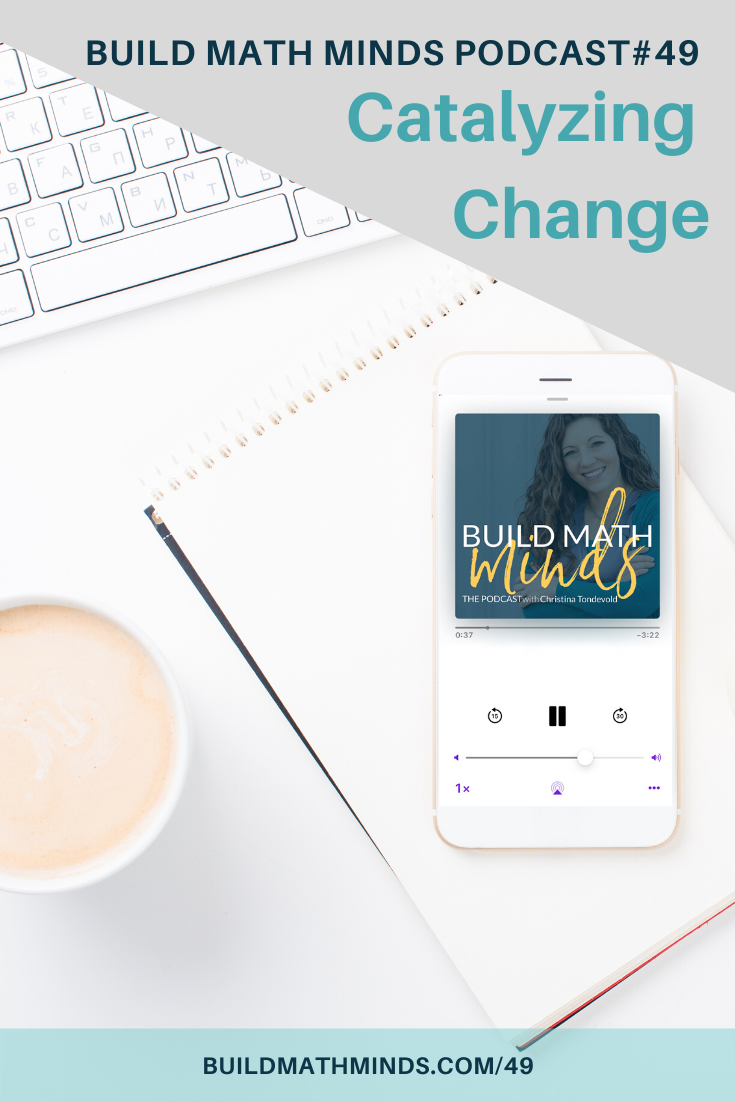Resources mentioned in this episode:
Catalyzing Change for Elementary School by DeAnn Huinker
DeAnn’s Virtual Math Summit session from 2017 (for Build Math Minds PD site members)
Welcome fellow Recovering Traditionalists to Episode 49. Today we are looking at Catalyzing Change.
Changing the way you teach math is hard and it can feel even harder when you think about all the other teachers in your district who aren’t changing their teaching. You think to yourself “Does it even matter? Next year’s teacher doesn’t teach this way so why should I take the time to adjust my teaching” or the ever popular thought of “When my students get to junior high or high school those teachers expect the kids to do____(fill in the blank)____, so I need to prepare them.”
First off, yes it does matter. Even if you are the only teacher in that school who is teaching math differently, you are giving your students a taste of what math can be like. One of my sons has never enjoyed reading, but this year he has a teacher who has made reading something he enjoys. He’s actually having fun. I don’t know what his experiences with reading will be with his future teachers but I’m so grateful that this year he’s actually excited about reading class. Even if it is just one year of seeing reading taught differently, it’s made a difference in him and how he talks about the subject now.
Second, let’s address the junior high and high school teacher thought. Do you know what actually is expected in those grades or are you just guessing? And if the expectation is different in those upper grades, it really shouldn’t be. One of the biggest ways to catalyze change is to make sure everyone is on the same page.
Catalyzing Change in High School Mathematics: Initiating Critical Conversations was a book published by NCTM in 2018 in the hopes of starting to change how mathematics is taught in high school. In 2019 DeAnn Huinker wrote an article in Teaching Children Mathematics (also published by NCTM) about how that book has lessons in it that can help catalyze change throughout all the grades.
On page 284 she writes:
“We build the foundation in the elementary grades to launch students on their mathematical journeys. Therefore, it is important for us to keep an eye on the mathematical horizon for our students, be aware of future expectations, and work toward a consistent pre-K–12 vision of mathematics teaching and learning. The purposes of this article are to overview Catalyzing Change and examine implications for our professional work. I begin by listing the four major recommendations for high schools and then elaborate on key messages. These include a need for equitable instruction that fosters positive mathematical identities and agency as well as a need for equitable structures, such as elimination of tracking and creation of a common course pathway. I close with next steps for collaborative conversations and actions.”
If your district is looking at catalyzing the change in math teaching then please make sure to read this article for ideas on how to spark the conversations that need to happen in order to analyze how math is taught from Kinder all the way through 12th grade. Most articles in Teaching Children Mathematics are for NCTM members only, but this article is one that is free for anyone to download.
For those of you who are Build Math Minds members, inside the PD site DeAnn did a session in the 2017 Virtual Math Summit all about high leverage teaching practices that could help jumpstart a conversation at your district on the best practices for teaching math across all grade levels. You can find that by logging into the member area, click on Virtual Math Summit and then go into the videos from 2017.
Subscribe and Review in iTunes
While you’re there, don’t forget to leave a review on iTunes too. I would love to know your thoughts and how we can make sure that we give you content that you will really enjoy.
To leave a review, head over to iTunes and click on “Ratings and Reviews” and “Write a Review.” I can’t wait to hear your thoughts about the podcast.




